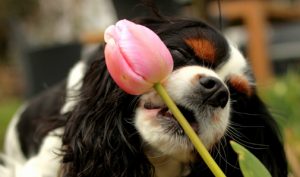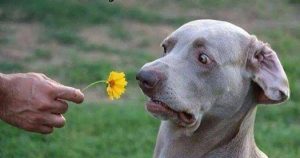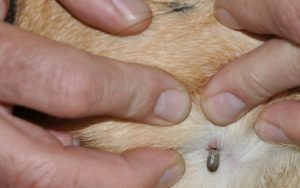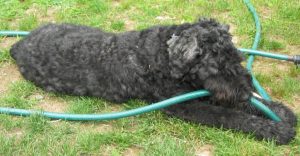Spring is officially here, and for many families this means getting out in the yard and planting that beautiful spring garden! If your family includes a four-legged member, it’s important to keep their safety in mind as the seasons change. There are not only numerous dangerous plants and flowers that are toxic for pets, but there are other things you need to be aware of if you want to have a safe and happy spring:

1. Choose plants wisely: As you’re coming up with plans for your beautiful new garden, steer clear of plants that are known to be toxic to pets. A few popular spring choices to avoid include the Azalea, Tiger Lily (and most Lilies in general, like Calla Lilies), Crocus, Amarylis, Carnations, Chrysanthemums, and the Tulip. Other plants to watch out for include most types of Aloe, select palms such as the Sago, Begonias, most types of Laurel, select Ivy and Fern varieties, and even most Pine trees! It seems like all plants are harmful to pets…
Be advised that certain plants may seem harmless, but actually have harmful parts that can prove fatal if your pet ingests them, such as Pine tree needles, Daffodil bulbs (or any bulb plant), Jade leaves, etc. As a rule of thumb, if a plant is waxy or has waxy parts to it, it is DEFINITELY dangerous for your pet to consume! It is especially dangerous that some plants such as Palm and Pine trees drop harmful seeds, needles, flowers, etc. because these parts fall onto the ground, where it is in the perfect place for your pet to eat it or chew it up.
 If you do choose to have one of these plants in your garden, or it is already there and difficult/impossible to remove the plant, do NOT leave your pet unattended in your garden! If possible, put some sort of barrier around the offending plants, or even coat the plants in a pet-deterrent such as Bitter Apple or Bitter Lime. Take the utmost caution so that your pet does NOT suffer for your garden’s beauty!
If you do choose to have one of these plants in your garden, or it is already there and difficult/impossible to remove the plant, do NOT leave your pet unattended in your garden! If possible, put some sort of barrier around the offending plants, or even coat the plants in a pet-deterrent such as Bitter Apple or Bitter Lime. Take the utmost caution so that your pet does NOT suffer for your garden’s beauty!
2. Beware of baits and fertilizers: Snail and rodent baits may be helpful in keeping unwanted pests out of your yard, but these products are also extremely dangerous for pets. Bait toxicity can be fatal, causing blood clotting disorders, brain swelling, or kidney failure. Herbicides, pesticides, insecticides, weed killers, and other garden substances (even if they are all-natural) could cause pet poisoning – especially if your pet licks its paws very often. Depending on the ingredients, ingestion of fertilizers can cause a variety of symptoms, ranging from gastrointestinal irritation to seizures and death. Fish fertilizer, blood/bone meal and cocoa mulch are highly toxic to pets, so seek immediate veterinary care of you suspect your pet has ingested a dangerous substance.
3. Protect against fleas and ticks: Pets should be protected against parasites all year long, but it’s especially important during the warmer months when pets are likely to spend time outside in the yard. Monthly flea and tick preventives can be applied directly to your pet and for extra protection, you might consider using a yard spray as well.

4. Watch out for unexpected guests and visitors: There are a bunch of other random and unexpected yard hazards to look out for, especially due to the ensuing rainstorms and increasing moisture that spring brings along with it. One of these dangers is fungi, such as mushrooms or toadstools, that love wet/damp conditions – especially after a fresh rainfall. Not all mushrooms are poisonous for your pet to eat, but you might as well be safe rather than sorry! For that matter, any kind of mold or mildew – whether it’s inside or outside – can prove to be harmful so make sure that you aren’t growing anything that you aren’t aware of! If you need to reduce the moisture in your home, a dehumidifier may be of great use to you. Other unexpected hazards to watch out for include insects such as Black Widow spiders, Brown Recluse spiders, wasps, bees, and other “guests” that could potentially be attracted to your hard and inflict damage on your pet. To minimize the possibility of these creatures visiting your yard, steer clear from plants that have tempting flowers that attract bees and other insects that bite, sting, or cause irritation in some way. You’d be surprised how many dogs have eaten bees, disturbed wasp’s nests, or dug into a spider’s web, only to be hurt by the insect. Stay watchful of any nests, webs, or other dwellings that insects or even small animals like rats and mice could have. Don’t leave out any kind of food that could attract small mammals, raccoons, bobcats, coyotes, possums, etc. because you never know what kind of an altercation your pet can get into!
5. Re-think your lawn and garden ornaments: If your pets love to chew, be careful about what kind of decorations you display in your garden or lawn. Dogs are known to try and eat or chew anything they can get their paws on, and NOTHING is exempt from this rule. I have heard of dogs eating light fixtures, gnomes, stones, pinwheels, statues, flags, and also chewing/eating parts of fences and enclosures! Assume that your dog could and would eat anything, and then plan your lawn or garden display accordingly.

As long as you are hyper vigilant about all of the possible hazards that your garden and yard could entail (there’s a lot of them, so keeping a list could be handy), you’ll be able to relax and be worry-free about your pet enjoying the yard. Pets should be supervised when they are in your yard anyway, even if you have a fence – you never know what or WHO could sneak up on your dog when they least expect it!